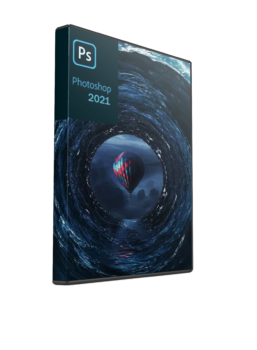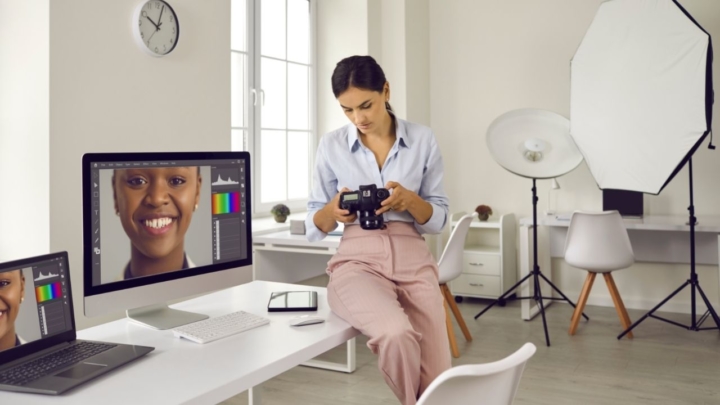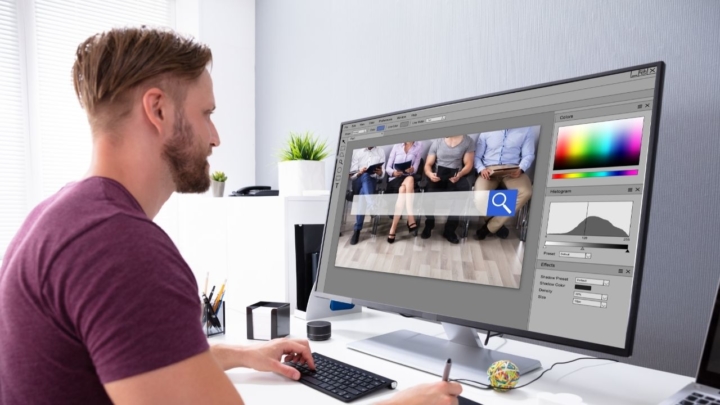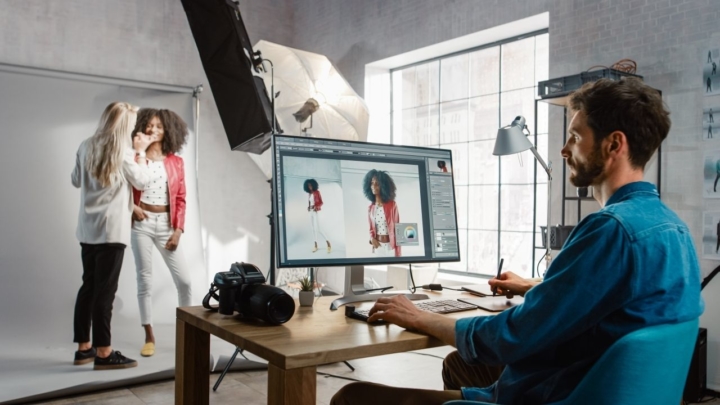A picture is worth more than a thousand words, so the appeal of a perfect photo in any context is important. But it's hard to get a great shot with a camera alone. Nowadays, beginners or experienced photographers can use photo editing software to achieve this. This buying guide is here to help you find the best photo editing software.
Here is our commitment, to make sure that we provide the best user experience and content quality:
You can support us by using our links to make your purchases (at no extra cost to you)! This sometimes earns us a commission which allows us to remain independent. More about us
Our selection
"When it comes to photo editing software, Adobe Photoshop remains the best of all. For artists, illustrators and designers around the world, Photoshop is a…"
"With its detailed and guided step-by-step procedures of each module, clear and simple interface and numerous one-click presets, Adobe Lightroom is our choice as the…"
"For many reasons, Luminar has quickly become one of the most popular photo editing programs for professional photographers around the world. You pay a one-time…"
"There are several excellent free photo editing software options, but GIMP is the most popular because of its professional quality features that are constantly updated."

When it comes to photo editing software, Adobe Photoshop remains the best of all. For artists, illustrators and designers around the world, Photoshop is a powerful and reliable photo editing software.
23.99 per month on AdobePhotoshop's masking, retouching, and layering tools are still among the most compelling on the market. Adobe Photoshop provides tools that you simply won't find in other photo editing software. If you're a photo editor working on graphic design projects or other multi-level tasks, Photoshop might be the photo editor for you. Photoshop offers several different predefined workspaces designed to eliminate excess tools that you don't need for your project.
Let's face it, Photoshop is primarily a photo editing software designed for professionals. The reason why many photo editing beginners have a hard time using Photoshop is that it offers a huge amount of tools. Of course, as you become more familiar with Photoshop and decide which editing tools you prefer, you can create and save your own custom workspace.

With its detailed and guided step-by-step procedures of each module, clear and simple interface and numerous one-click presets, Adobe Lightroom is our choice as the best photo editing software for beginners.
11.99 per month on AdobeSometimes called Adobe Photoshop "light," there's nothing a beginning photography enthusiast can't do with Adobe Lightroom Classic. This Lightroom offers guided step-by-step procedures for each module to accelerate your learning curve, allowing you to quickly master your workspace. Lightroom was launched in 2007 to complement Adobe Photoshop as an all-in-one photo editing software with image cataloging and raw processing capabilities. Where Photoshop excels in photo manipulation, Lightroom is a more than capable photo enhancement tool.
Lightroom works perfectly with iPads, iPhones and Android devices for automatic photo transfers with automatic syncing. Photographers going from beginner to advanced can simply add Adobe Photoshop to enjoy a complete photo editing software.

For many reasons, Luminar has quickly become one of the most popular photo editing programs for professional photographers around the world. You pay a one-time fee rather than a monthly subscription. And the software offers a ton of built-in tools and features!
37,60 £ on SkylumLuminar is a one-stop shop for photo editing that can be used on its own or as a plug-in with Lightroom, Photoshop and even Apple Photos. Believe it or not, Skylum Luminar uses the same keyboard shortcuts as Adobe's Lightroom. This is especially useful if you're already familiar with the Lightroom interface. And, like Lightroom, you can use Luminar as both a photo editor and photo organizer. Luminar has gained popularity mainly because of its AI slider, which applies quick automatic fixes to your photos.
Its intelligent algorithms can analyze photos and, with one click, correct imperfections, improve colors and add dramatic elements, which can greatly streamline the workspace. Its user-friendly interface makes it easy to move through tabs or between projects. Luminar has a gentle learning curve, making it more accessible to beginners, even though it is primarily aimed at professionals.

There are several excellent free photo editing software options, but GIMP is the most popular because of its professional quality features that are constantly updated.
Free on GimpThis open source photo editing software is available on Windows as well as on macOS and Linux. It allows you to edit photos as well as to create graphics. The program is based on an interface similar to professional software such as Adobe Photoshop and allows you to work on an image using a system of layers that allows you to superimpose modifications without altering the original image. GIMP offers a large number of tools, and is aimed at an advanced user. However, it is possible to learn to master the main functions of the program thanks to the many tutorials published directly on the official website.
GIMP includes classic editing tools (cropping, color balance, saturation, etc.) but also offers more advanced retouching tools such as the corrector tool or the cloning tool, which will allow you, for example, to remove annoying elements from an image, or to correct an unsightly button on a face.
Any specific needs?
The best photo editing software in 2021
The best entry-level photo editing software
The best lifetime license photo editing software
The best free photo editing software
Your guide :
Rate this buying guide :By rating this buying guide, you are helping us to reward our best writers. Thank you!
| The best | It's cheap | Lifetime license | Free | |

In accordance with our commitment, this buying guide does not contain any sponsored products. |
 9/10 |
 7/10 |
 8/10 |
 8/10 |
| OUR SELECTION |
Adobe Photoshop
|
Adobe Lightroom Classic
|
Luminar Skylum
|
GIMP
|
|
When it comes to photo editing software, Adobe Photoshop remains the best of all. For artists, illustrators and designers around the world, Photoshop is a powerful and reliable photo editing software.
|
With its detailed and guided step-by-step procedures of each module, clear and simple interface and numerous one-click presets, Adobe Lightroom is our choice as the best photo editing software for beginners.
|
For many reasons, Luminar has quickly become one of the most popular photo editing programs for professional photographers around the world. You pay a one-time fee rather than a monthly subscription. And the software offers a ton of built-in tools and features!
|
There are several excellent free photo editing software options, but GIMP is the most popular because of its professional quality features that are constantly updated.
|
|
|
Interface
|
|
|
|
|
|
Learning curve
|
|
|
|
|
|
Features
|
|
|
|
|
|
Multiplatform availability
|
PC, Mac, Mobile
|
PC, Mac, Mobile
|
PC, Mac
|
PC, Mac, Linux
|
|
Target audience
|
Amateur, professional
|
Amateur
|
Professional
|
Amateur, professional
|
Help us improve this table:
Report an error, request the addition of a feature to the table, or suggest another product. Thank you for your kindness!
We spend thousands of hours each year studying the major specialized websites, analyzing products of hundreds of brands and reading user feedback to advise you on the best products.
We are a product review company with a single mission: to simplify your buying decisions. Our research and testing helps millions of people every year find the best products for their personal needs and budget.
To support us you can: use our links to make your purchases (which often earns us a small commission), share our articles on social networks, or recommend our site on your blog. Thanks in advance for your support!

Although the vast majority of photo editing software can handle basic edits, more complex and specific editing techniques will be easier to accomplish with some software than with others. You should consider your most common editing tasks when choosing a photo editing software. What are your priorities when editing an image? Do you mainly stick to basic adjustments like exposure and white balance? Or do you like to get creative with text, filters and brushes? The answers to these questions will guide you to the right photo editing software for you.
Do you want photo editing software that can both edit your photos and organize them? Some software can do both! Think about your current photo organization system and if it works for you. If you like your images organized and in one place, an organizing and editing program like Adobe Lightroom might be a better fit for you.
Finding a photo editing workspace that you enjoy is essential to creating great edited photos. If you're a novice editor, you may not have an established workspace when editing your photographs. In this case, choose a photo editor that you like for other reasons and develop your workflow to fit the software. If, on the other hand, you are an experienced photo editor with an established editing workspace, you should consider the interface of the software you are interested in. Is the interface designed to complement your workspace and is it user-friendly?
After editing a photo, you probably want to share it on social networks. Some of the best photo editing software has a built-in photo sharing feature to make photo sharing quick and easy. Check out how a given software handles photo sharing before you commit. Some programs, such as Lightroom, can be adjusted to facilitate photo sharing directly on WordPress. Others have social sharing buttons that allow you to post your edited images to Instagram and Twitter without ever leaving the editing software.
As your photography skills grow, so will your photo editing skills. The question is, can your photo editing software grow with you? Consider choosing software that supports downloadable presets, effects, filters, and brushes.
It may sound silly, but if you're looking for photo editing software that can convert RAW files, check to see if the RAW format supported is the same as your camera's RAW. This is because there are different types of RAW files. You may experience image quality problems when the software does not support the correct RAW version.
Simply put, photo retouching, or photo editing, is the adjustment of the color or exposure of an image to help improve the original. With techniques such as tint adjustments, tone curves, color balance and spot adjustments, you can give a photo a special look that you would never get naturally with your camera alone. With photo retouching, a photographer can add his or her own style to an image or improve the appearance of the original photo.
The vast majority of photographers retouch their photos in some way. You don't necessarily need photo editing software to make image adjustments either. Even on the most basic smartphones on the market today, you'll find a built-in photo editing application. By simply increasing the brightness or changing the white balance of a photo, you're already editing.
Although it starts with very basic settings, photo editing can become much more advanced. With more professional software such as Lightroom or Luminar, you can make more precise and profound changes to a photo. For example, you can take an image with regular colors and adjust them to favor a certain color tone. Similarly, you can soften your image by accentuating the shadows to give it a matte look.
The options you have when editing photos are endless. Even better, there are an infinite number of ways you can mix and match adjustments to achieve a specific look. After experimenting with different adjustments, a photographer will begin to define an editing style that is unique to them. This style is what ultimately sets many photographers apart from one another.

Photography retouching and manipulation are similar in that they both enhance an image. Although the former only changes what is already present in the image and the latter creates new elements, they both modify an image with creative intent. The result of each creates a certain style that matches the photographer's style.
In most cases, retouching and manipulating photos requires much of the same color and exposure settings. The difference being that photo manipulation uses them not only to style the overall image, but also to add new elements to it.
Touching up and manipulating photos are different, because touching up leaves the original attributes of an image intact, while manipulating alters the reality. In addition to the adjustments made, these different types of photo editing require completely different skills and software.
With photo editing, you can make any type of adjustment with basic apps on your phone or computer. Then you can get more editing options by downloading more advanced photo editing software. Photo editing is relatively easy to learn and can be understood with some trial and error. Since most of the adjustments can be made with sliders, it's pretty straightforward.
Manipulations are a different story. They require more advanced tools such as Photoshop. With software like this, you can cut out objects , create masks or even paint new effects from scratch. The options are endless in this software and it offers tools that are not available anywhere else.

The software rental system or SaaS (Software as a Service) consists in paying a monthly subscription for the right to continue using the software. When you stop paying, the software is remotely disabled. Adobe is a company that has come under heavy criticism from users in recent years for its move to this licensing model. You may even be reading this article in an effort to find an alternative to Adobe products. Many people don't like the rental model, as it can seem expensive and forces you to make regular monthly payments. Where SaaS photo editing software is strong is that you're guaranteed to use up-to-date software.

It's like buying a license that gives you the right to install and use the software on one or more computers. You don't buy the software, you just buy a license to use the software. The point to consider when purchasing a license is how often the company releases a new version. Some companies use a minor and major release schedule for their photo editing software. Generally, minor versions are free while major versions are a paid upgrade. Some software uses a 12-month release cycle, which can make the cost similar to the rental model. Others, have a lifetime license model where you will receive new updates for as long as the software exists.

Here, you again get a license to use a software, but the license is free. Obviously, there are some drawbacks to this freebie. Sometimes there can be long intervals between releases, because new releases depend on the developers. When you download a new version of free photo editing software, it may not be stable. Rather than having a dedicated team of testers, there is more reliance on users to report problems. If you're an advanced user, you may be using features that few people have used and therefore encounter more problems.
The most obvious advantage of using a photo editing application on a smartphone over photo editing software on a PC or Mac is convenience. You always have your smartphone with you, but you don't always have your PC available anywhere. If you capture a great photo and want to publish it right away, a quick edit with a photo editing app on your smartphone can get it done in minutes. There are countless photo editing apps available on both Android and iPhone these days.
So what you gain in terms of ease of use and convenience when editing photos on your phone, you lose in terms of the possible editing options. By this we mean that smartphone photo editing apps can't compete with Adobe's office suite in terms of control and processing. So when you edit photos on your smartphone, they'll look great for Instagram, Snapchat, or any other social network, but when it comes to professional-quality photography standards, they just don't cut it.
When you edit on your PC or Mac, you definitely have more control. Anyone who tells you otherwise is wrong. Photo editing software can allow you to make more extensive adjustments to an image without sacrificing quality. However, because RAW images contain more information, the software must be able to handle the processing. This is where software like Adobe Lightroom and Adobe Camera Raw can be of great help. Lightroom tends to be the software of choice for photographers and is known for its high-quality presets and a plethora of editing tools. Presets can save photographers considerable time in post-processing.
The most compelling argument against computer-based photo editing software is the lack of mobility. Even if you have a laptop, you still have to carry a large camera. This can also include things like a charger, a laptop case and your smartphone. If you're on the go and taking pictures at the same time, it can be too much to carry. While there are many benefits to using photo editing software on your PC or Mac, the value of doing so largely depends on the situation.
So, in some cases, it turns out that editing on your phone might be the way to go for you, especially if you're editing photos primarily to post them on social networks At the same time, if you're looking to do professional photo editing, you'll probably need to do some editing on a laptop or desktop computer using dedicated software.

Automatic image enhancement
Most photo editing software, especially the best ones, come with this feature. It can be useful for you to automatically correct various common imperfections present in photos. Many professional image editing services use this feature to improve the appeal of their photos by removing defects. This is the fastest and most effective way to make corrective changes to your photos at home, from your own computer.
Data compression
This task is especially important when you want to post your photos on a website. It is important to compress your images before uploading them, as this can help reduce the loading time of the website. However, compressing images can reduce their quality in some circumstances. But with the help of photo editing software, you can compress your images without losing quality. This can reduce the storage space required for your photos.
Image selection
This is one of the best features offered by photo editing software. You can select a certain part of your images for editing. This feature allows you to make changes to the selected area without affecting the entire image. Some of the tools that can be used to select a specific part of the image are the selection tool, lasso tool, magic wand tool, etc.
Use of layers
Software like Adobe Photoshop allows the use of layers to edit your images. You can add multiple layers to your images that can be processed separately. You can edit the layers separately without affecting the whole image. This feature can help you make changes to your images at different levels.
Resize images
Photo editing software also helps you to resize or crop your images according to your specific size requirements. This feature can be useful to adjust the height and width of your images according to your needs.
Background Removal or Clipping
We all know that photo editing is essential to remove the background. You have put a lot of effort into taking good photos, but you may not be happy with the background. There may be many unnecessary objects or people in the background. This is a big problem, but you can cut out the background of your photo and set a new one as you like.
Color correction
This type of editing is necessary for color and lighting related defects. Sometimes the normal color can change due to lighting, environment, perspective and camera settings at the time of shooting. It is possible to solve this problem with photo editing software. Typically, color correction is used for fashion photography, modeling images, etc.
In our opinion, the best brands of photo editing software in 2022 are :
Adobe, originally called Adobe Systems Incorporated, is an American multinational corporation incorporated in Delaware and based in San Jose, California. It has historically specialized in software for creating and publishing a wide range of content, including graphics, photography, illustration, animation, video and print. The company has expanded into digital marketing management software. Photoshop, the photo editing software, remains one of the brand's flagship products.
Skylum is a global imaging technology company. Skylum enables millions of photographers to make incredible images faster. In particular, the company offers a photo editing software called Luminar that has a photo editing automation feature using powerful artificial intelligence.
In less than two decades, DxO has become one of the most innovative French companies in the field of digital photography and image processing. It designs and sells advanced photo editing software for amateur and professional photographers. DxO's software solutions, based on its in-depth knowledge of optical and digital science, provide you with highly effective image correction and processing tools.
ACD Systems is an independent digital image editing and management company with offices in the United States and Canada. The company was founded in 1994 in Texas by Doug Vandekerkhove. Its products include ACDSee photo editing and management software.
Pixlr is a cloud-based set of image editing tools and utilities, including a number of photo editing software and a photo sharing service. The Pixlr suite was originally intended for non-professionals, but current applications range from simple to advanced photo editing.
The diagram below will help you to get an idea of the typical prices for each price range (entry-level, mid-range and high-end).
However, more expensive does not necessarily mean better.
We therefore advise you to always consult our ranking before deciding, rather than blindly relying on price ranges.
Crop and clean up your images
It's always best to make sure your horizon is horizontal when photographing. It's also best to crop your photo to improve minor compositional details. And to get sharp images, most photo editing software has a spot removal tool. Methodically work around your photo until you have a spotless image.
Adjust white balance
White balance refers to color levels, not exposure levels. If your image has an overall color tone that you find unpleasant or unnatural, you can adjust the white balance to correct it. Note that JPG files, because they capture much less digital data than RAW files, offer a minimal amount of white balance adjustment when retouching.
Adjust exposure and contrast
Exposure adjustment is the process of making the photo exactly as bright or dark as you want. Note that as you increase the brightness, there may be more noise. That's why it's always best to get the exposure right when you first take the picture. Contrast, on the other hand, is the range from dark to light. Generally, you want a medium contrast that avoids either extreme. But if you prefer one of these effects, you can adjust contrast to achieve it.
Adjust color vibrancy and saturation
Once you've adjusted white balance, you can further refine the colors in your photos with the saturation and vibrancy controls. The distinction between the two is subtle: increasing vividness increases color intensity in neutral tones and maintains color intensity in brighter colors. Increasing saturation makes all colors in the image more intense. When bright colors appear, it can give the photo a more dramatic look.
Adjust sharpness
Play around with the sharpening features of your editing photo software to see the effect each one has. You can try a "clarity" or "structure" tool. This makes the edges of objects in the photo stand out more, giving the overall image a more punchy look. Note that sharpening an image cannot turn a blurry photo into a sharp one. No editing tool can do that. Also, if you sharpen an image too much, you can create an artificial halo effect.
Unless you want to splurge on an expensive single-lens reflex (SLR) camera, you don't need a professional-grade camera to use photo editing software. Today's smartphones can generate high-quality photos, or you can opt for an entry-level digital single-lens reflex (DSLR) camera, or a hybrid model, if you're serious about photography.
Yes, on Windows 10, there's the Photos app that displays photos and also has basic editing tools. This software that comes with the operating system can enhance, crop, and rotate images. It also offers a personalized organization of your photos. Finally, this free, built-in photo editing software lets you share your photos via email and directly on social networks.
On one side, Adobe Photoshop is a tool that lets you edit and make detailed adjustments to any image. On the other side, Adobe Lightroom is the platform that allows you to organize, import and export photos to many other formats. It also has some photo editing tools, but not as rich as Photoshop. Both tools can be used in a complementary way and are part of the Adobe Creative Cloud (CC) suite of software.
Some photo editing software offers a single computer license. It is not uncommon for photography professionals to have both a Windows PC and a Mac. This means they will have to purchase a second license to use the photo editing software on a second device. On the other hand, the best photo editing software, such as Adobe Photoshop, offers a cross-platform license that can be used on an unlimited number of workstations.
Every month we help more than 1 000 000 people buy better and smarter.
Copyright © 2022 - Made with ♥ by buyingbetter.co.uk
Your reviews and buying guides 0% advertising, 100% independent!